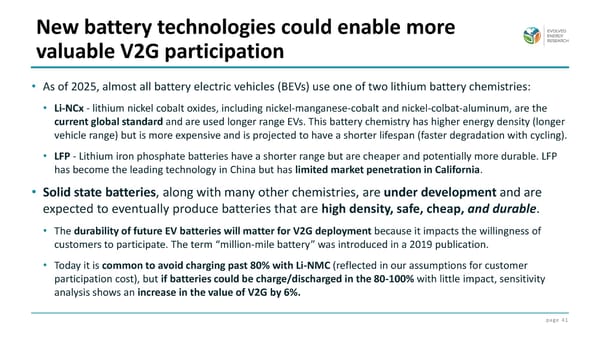page 41 • As of 2025, almost all battery electric vehicles (BEVs) use one of two lithium battery chemistries: • Li-NCx - lithium nickel cobalt oxides, including nickel-manganese-cobalt and nickel-colbat-aluminum, are the current global standard and are used longer range EVs. This battery chemistry has higher energy density (longer vehicle range) but is more expensive and is projected to have a shorter lifespan (faster degradation with cycling). • LFP - Lithium iron phosphate batteries have a shorter range but are cheaper and potentially more durable. LFP has become the leading technology in China but has limited market penetration in California. • Solid state batteries, along with many other chemistries, are under development and are expected to eventually produce batteries that are high density, safe, cheap, and durable. • The durability of future EV batteries will matter for V2G deployment because it impacts the willingness of customers to participate. The term “million-mile battery” was introduced in a 2019 publication. • Today it is common to avoid charging past 80% with Li-NMC (reflected in our assumptions for customer participation cost), but if batteries could be charge/discharged in the 80-100% with little impact, sensitivity analysis shows an increase in the value of V2G by 6%. New battery technologies could enable more valuable V2G participation
 Exploring the Value of Vehicle to Grid (V2G) for California Page 40 Page 42
Exploring the Value of Vehicle to Grid (V2G) for California Page 40 Page 42